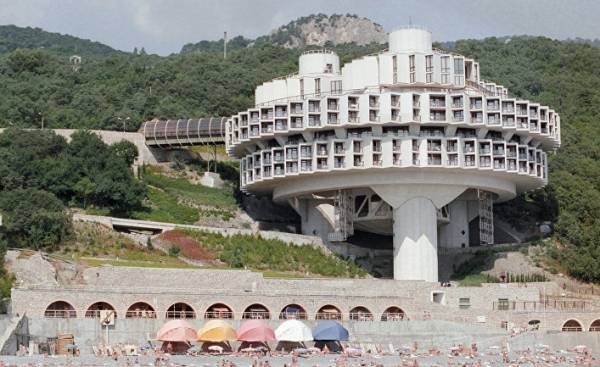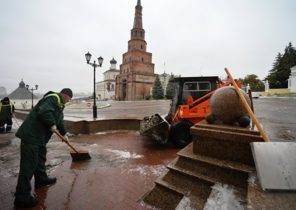
In the former USSR, the rest was an essential component of life of the Soviet man. It is in this era, the Kremlin is building across the country, dozens of resorts, where the civil servants could spend one or two weeks of vacation is also paid by the state. Journalist Amidi Maryam (Maryam Omidi) launched a project in which the history of former Soviet sanatoriums intertwined with their architecture.
After twenty-five years after the collapse of the Soviet Union many of these health centers continue to accept guests. Some of them have become health resorts. However, not everyone was lucky, and many of the resorts are already in a dilapidated condition.
“In Soviet times, the holiday was seen as something really important, says Maryam Omidi. — The appointment [of resorts] was to enable workers to recover their strength after many months of hard work during the year and then with new energy to get back to work”.
Thus, Amidi decided to launch a Kickstarter project called “the Last refuge: the strange charm of Soviet-era sanatoria” (The Last Resort: the Strange Beauty of Soviet Sanatoriums) — which is going to tell the story of these buildings since their construction to the present day. In an interview with CNN reporter explained the concept of your project.
The key role of sanatoria
As explained by Maryam Omidi, the Soviet people were proud of their own philosophy of leisure and recreation, considering them an integral part of socialism, whose ideals defended. Thus, the resorts are considered as a key component of Soviet superiority.
The vacation was seen as a time of relaxation, and here the material was allowed to prevail over the spiritual. According to Omidi, this philosophy gave the architects the “green light”: they were able to implement the “bold and brilliant ideas” without regard to cost. Throughout the former Soviet Union, we find resorts that are excellent examples of various architectural styles.
Construction of resorts on the initiative of the Kremlin began in the 1920-ies and ended only with the collapse of the Soviet Union. In 1922 the Labour code stipulates the right of civil servants on a two-week vacation to rest from an entire year’s work and to increase own productivity. In 1990, at the peak of popularity, Soviet sanatorium can take up to half a million “guests”.
Methods of treatment used in spas, where happened to be Miriam, struck her as rather unusual. So, she talks about her experience of making dry carbon baths. Yes, you heard right. This procedure is capable of “curing everything from infertility and ending depression.” For this purpose the body is placed in a special plastic bag, which is tightly knotted around the neck. Inside the bag is pumped carbon dioxide.
The sanatorium of the former Soviet Union are very different from European and from the resorts and spas that exist in America. “[There are] no fancy massages with aromatic oils or yoga at sunset,” says the journalist. Even former Soviet sanatorium, which today became the resort, continue to follow a more utilitarian ideology, not paying too much attention to luxury. This is largely due to “utopian ideals that once guided their creators,” she adds.
According to Amidi, one of the most famous Soviet resorts is the sanatorium “Druzhba”, located in the Crimea. A futuristic architectural style, which made the building in 1985, even discomfited the United States, which decided that it was a rocket launcher.
The book that plans to publish Omidi, will be the first collection of health resorts of the Soviet Union, combining text and photos. The journalist intends to focus only on the operating spas. From the book, the reader will be able to learn about the utopian ideals on the basis of which were built in every resort, on the non-traditional methods of treatment and even to read the testimonies of some former guests.
How did the idea for the book?
The idea to write a book on the history and architecture of the Soviet health resorts, was born of Mary Omidi in 2015 after the reporter visited the resort Khoja Obi Garm in Tajikistan. The environment and treatment of employees immediately attracted her attention. Since then she has been busy promoting the project.
The project has a team of six photographers who, together with Mary Omidi plan to make a trip to the former Soviet Union and collect documentary material about the most interesting architectural structures of that era. As reported on the website of the project, in addition to photos of the exterior and interior members intend to interview guests and employees of the resorts.
However, is not without its difficulties, one of them is access to a number of health centers. In some regions, where the building, the political regime is authoritarian, and the work of foreign photographers and journalists there can be hostile. However Omidi emphasizes that such cases are not many, and most regions are adopting a more open policy of not requiring visas and bureaucratic procedures.
One of the main goals of the book is to be of interest to readers who themselves might want to visit some of these places. While work is still not completed (the release is planned for the spring of 2017), you can see the photo gallery, which presents the five health resorts of the Soviet era, which are still in use.







